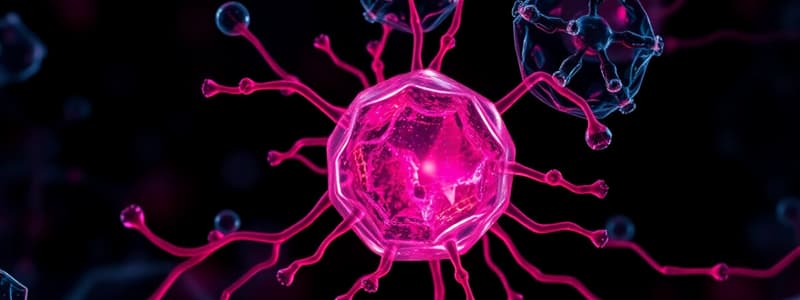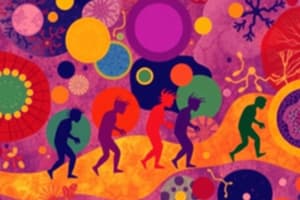Podcast
Questions and Answers
What is the primary focus of biology?
What is the primary focus of biology?
- Study of organisms' habitats
- Study of life (correct)
- Study of chemical processes
- Study of physical laws
Which of the following scientists is credited with developing the first rudimentary microscope?
Which of the following scientists is credited with developing the first rudimentary microscope?
- Anton van Leeuwenhoek
- Matthias Schleiden
- Hans and Zaccharias Janssen (correct)
- Rudolf Virchow
What does the cell theory propose about nucleated cells?
What does the cell theory propose about nucleated cells?
- They are formed solely through cellular respiration.
- They are the basic structure of plants and animals. (correct)
- They are the only type of cells found in animals.
- They can exist independently of other cells.
Which of the following is NOT one of the basic postulates of the modern cell theory?
Which of the following is NOT one of the basic postulates of the modern cell theory?
What is the primary function of mitochondria in a cell?
What is the primary function of mitochondria in a cell?
What role do centrioles play during cell division?
What role do centrioles play during cell division?
What is the primary role of the cytoplasm in a cell?
What is the primary role of the cytoplasm in a cell?
Which structure is responsible for maintaining cell shape?
Which structure is responsible for maintaining cell shape?
Who hypothesized that all living organisms are the sum of single cellular units?
Who hypothesized that all living organisms are the sum of single cellular units?
Which of the following correctly describes chloroplasts?
Which of the following correctly describes chloroplasts?
Which component of the cell is responsible for regulating what enters and exits the cell?
Which component of the cell is responsible for regulating what enters and exits the cell?
What is a characteristic feature of mitochondria?
What is a characteristic feature of mitochondria?
Which of the following options best describes the relationship between cells and life?
Which of the following options best describes the relationship between cells and life?
What is the primary function of the cell membrane?
What is the primary function of the cell membrane?
Which structure is known as the packaging plant of the cell?
Which structure is known as the packaging plant of the cell?
What essential role does the smooth endoplasmic reticulum play in the cell?
What essential role does the smooth endoplasmic reticulum play in the cell?
What is the main component contained within ribosomes that is essential for protein synthesis?
What is the main component contained within ribosomes that is essential for protein synthesis?
Which organelle is responsible for breaking down waste materials in the cell?
Which organelle is responsible for breaking down waste materials in the cell?
What type of endoplasmic reticulum contains ribosomes?
What type of endoplasmic reticulum contains ribosomes?
What is the primary content of the nucleolus found within the nucleus?
What is the primary content of the nucleolus found within the nucleus?
What is the function of the phospholipid bilayer in the cell membrane?
What is the function of the phospholipid bilayer in the cell membrane?
Flashcards are hidden until you start studying
Study Notes
Biology
- The study of life
- Derived from the Greek words "bios" (life) and "logos" (study of)
- Aristotle is considered the father of biology
- Charles Darwin is considered the father of modern biology
The Cell
- The basic unit of life
- Cells possess several properties including organization, evolutionary adaptation, response to the environment, energy processing, regulation, reproduction, and growth and development
Hierarchy of Biological Organization
- A hierarchy demonstrates the levels of increasing complexity in living organisms
- Cell, Tissue, Organ, Organ system, Organism, Population, Community, Ecosystem, Biome, Biosphere
Tools for Studying Cells
- Microscopes are used to study cells
- Janssen invented the compound optical microscope.
- Robert Hooke created the first rudimentary microscope and discovered the cell (named it "cellulae") while observing cork oak bark.
- Anton van Leeuwenhoek made a more advanced microscope that allowed him to see microscopic "animalcules" in water.
The Cell Theory
- The study of cells is called cytology.
- Proposes that nucleated cells form the basic structure of plants and animals.
- Proposed by Matthias Schleiden (1838) and Theodor Schwann (1839)
- Rudolf Virchow expanded the theory by concluding that all living organisms are made up of single cellular units and that cells replicate.
Modern Cell Theory
- All living substance is localized in cells.
- The cell is the basic unit of structure and function.
- Cells replicate to make more cells.
- A unicellular organism can exist as a single cell.
- A multicellular organism is an aggregate of individual cells at similar levels of organization.
The parts of a cell, structure and function
- Major parts of the cell include the nucleus, cell membrane, and cytoplasm
The cytoplasm
- A gel-like fluid that provides a platform for organelles within the cell.
The cell membrane
- A phospholipid bilayer with a head end facing the inside and outside of the cell and a tail end facing each other.
- Acts as a barrier between the cell's contents and the external environment.
- Allows the transport of essential nutrients into the cell and waste products out of the cell.
The nucleus
- The control center of the cell (regulates cell function and structure).
- Encased by a nuclear membrane surrounding a fluid called nucleoplasm.
- Contains chromatin threads composed of deoxyribonucleic acid (DNA), the genetic material of the cell.
- The nucleolus is a dense region of ribonucleic acid (RNA) in the nucleus and is the site of ribosome formation.
Other cell structures and functions
- Endoplasmic reticulum is an enclosed membrane network of flattened sacs.
- Smooth ER lacks ribosomes and is involved in lipid and carbohydrate synthesis, membrane building, transportation of vesicles, enzyme production, muscle cell contraction, and hormone synthesis.
- Rough ER contains ribosomes and is involved in protein manufacture, antibody and insulin production, and transporting proteins into the smooth ER.
- Ribosomes are tiny organelles containing RNA and specific proteins within the cytoplasm. They are involved in protein production using RNA and amino acids.
- Golgi apparatus/body is the packaging plant of a cell. Processes and packs macromolecules (proteins and lipids) before their transport to their destination.
- Lysosomes are small "stomachs" that move within the cytoplasm. Breakdown waste materials and cellular debris, functioning as the cell's garbage collector.
- Mitochondria (plural) are one of the largest organelles in the cell. Contain their own DNA which makes them semi-autonomous in function. Generate ATP through cellular respiration. They possess a double membrane and are known as the powerhouse of the cell.
- Chloroplasts (plant cells) convert light energy into stable chemical energy through photosynthesis.
- Cell wall (plant cell) is a structural layer surrounding some types of cells, located just outside the cell membrane.
- Centrioles (animal cell) contain microtubules that help separate and move chromosomes during cell division.
- Microtubules (animal cell) are long, hollow tubes that act as girders, giving the cell its shape. They may also help send signals from the membrane to the nucleus.
Laboratory Activity No. 1: Cell observation
- To bring:
- Alcohol
- Toothpick
- Glass slides and covers
- To borrow at school:
- Compound microscope
- Methylene blue
Review: The Parts and Function of a Microscope
- The text provides a breakdown of different components of a microscope. The specific components are not clear but it's important to review the parts of a microscope ahead of the laboratory exercise.
Studying That Suits You
Use AI to generate personalized quizzes and flashcards to suit your learning preferences.




